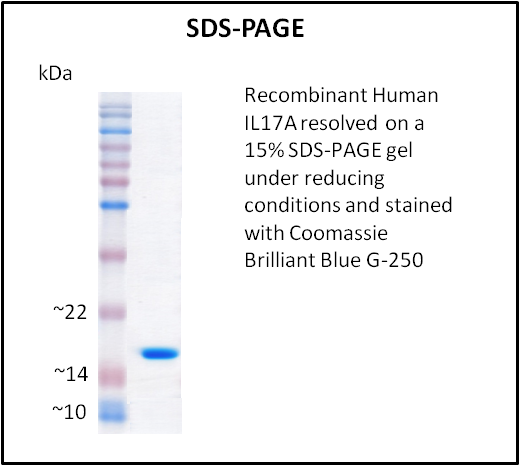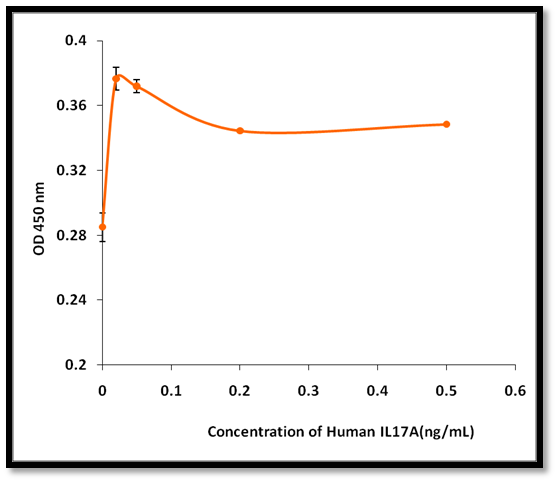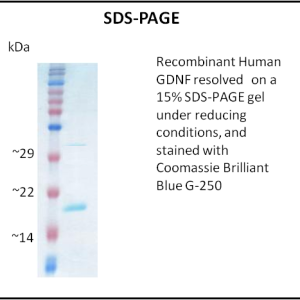Product Details
- Product Name: Recombinant Human IL17A (E. coli)
- Product Type: Cytokines
- Catalog Number: Z100465
- Unit Size: 25 µg
- Species: Human (Homo sapiens)
- Gene Symbol: IL17A
- Gene ID: 3605
- Accession Number: Q16552
- Expression System: E. coli
- Molecular Weight: ~16 kDa (monomer), 32 kDa (disulfide-linked homodimer)
- Form: Lyophilized powder
- Purity: > 95% (SDS-PAGE)
- Endotoxin Level: < 1.0 EU/µg (LAL method)
- Appearance: White to off-white lyophilized powder
- Formulation: Lyophilized from PBS, pH 7.5 (0.2 μm filtered)
- Function: Induces IL-6 secretion in primary human fibroblasts (ED₅₀ ≈ 2.0 ng/mL; specific activity >5.0 × 10⁵ units/mg)
- Storage:
- Lyophilized: –70°C (≥ 12 months)
- After reconstitution:
- 2–8°C (≤ 1 month)
- –20°C (≤ 6 months with carrier protein)
- Avoid repeated freeze/thaw cycles
- Shipping: Dry ice
- Usage: For research use only; not for diagnostic or therapeutic applications
Overview
IL17A is the prototypical member of the IL-17 cytokine family and is secreted as a disulfide-linked homodimer. It is a key mediator in antimicrobial host defense, chronic inflammatory responses, and autoimmune pathology. IL17A signals through the IL17RA/IL17RC receptor complex, activating downstream pathways that promote the release of proinflammatory cytokines and chemokines, thereby enhancing neutrophil recruitment and bridging innate and adaptive immunity.
Due to its pivotal role, IL17A has been implicated in diverse disease contexts, including psoriasis, rheumatoid arthritis, inflammatory bowel disease, and tumor microenvironment modulation. Recombinant human IL17A expressed in E. coli is supplied as a tag-free, biologically active protein, retaining its natural conformation and potency, and is a reliable tool for studies on immune regulation, cytokine signaling, and inflammation research.
Key Features and Benefits
- Potent Biological Activity: Induces IL-6 expression in primary fibroblasts (ED₅₀ ≈ 2.0 ng/mL).
- High Purity & Low Endotoxin: >95% purity, <1.0 EU/µg endotoxin, ensuring consistency in sensitive assays.
- Tag-free Preparation: Preserves native protein structure and receptor binding.
- Stable Lyophilized Form: Optimized for long-term storage and reproducible results.
- Broad Research Applications: Applicable to inflammation, cytokine signaling, and immune modulation studies.
Reconstitution Instructions
To ensure optimal activity and performance:
- Centrifuge the vial: Briefly spin to collect all lyophilized material.
- Reconstitute: Add sterile distilled water to a final concentration of ≥0.1 mg/mL.
- Mixing: Gently swirl or tap until dissolved. Do not vortex.
- Dilution: Dilute further into appropriate buffer or culture medium for use.
- Storage: Store aliquots at 2–8°C for ≤1 month, or at –20°C for ≤6 months with carrier protein. Avoid repeated freeze–thaw cycles.
Quality Control (QC)
- Purity confirmed by SDS-PAGE (>95%)
- Endotoxin level determined by LAL assay (<1.0 EU/µg)
- Bioactivity validated by IL-6 induction in human primary fibroblasts
Caution
- This product is intended for laboratory research use only.
- Not approved for use in humans or animals for diagnostic, therapeutic, or clinical purposes.
Disclaimer
- For research use only.
- Not for human or veterinary applications.
- Not intended for therapeutic or diagnostic procedures.
- No warranties are expressed or implied beyond the stated intended use.
- Users are responsible for compliance with all applicable regulations.
References
- Tang, A., Caballero, A. R., Bierdeman, M. A., Marquart, M. E., Foster, T. J., Monk, I. R., & O’Callaghan, R. J. (2019). Staphylococcus aureus superantigen-like protein SSL1: A toxic protease. Pathogens, 8(1), 2.



